
Looking to Get Past Tariff Setbacks? Avoid These 6 Procurement Mistakes
- Tariffs are set to increase input costs for businesses across the world.
- Among internal functions, procurement can play a key role in adapting to the new tariff environment.
- Procurement teams can leverage AI-powered technology to anticipate and prepare for various outcomes.
June 10, 2025 | Procurement Strategy 3 minutes read
How will tariffs impact different businesses? Surely, they will increase raw material costs, reduce profit margins, and even cause supply chain disruptions. When it comes to the impact of tariffs, companies today have more questions than answers. What would happen if overseas suppliers suddenly halt supply or raise prices?
Can the business bear these extra costs, or should it pass on additional costs to customers? What if customers switch to competitors?
Can the business find new vendors in nearby regions who can supply quality goods at competitive prices?
In Gartner’s 2025 Tariff Volatility Survey, 31 percent of respondents said they are ready to pass 81-100% of tariff increase to customers. As business and procurement leaders ponder over these issues and wait for more clarity on tariffs, they must keep some things in mind.
Tariffs Are Unpredictable, But Your Response Doesn’t Have To Be
Get real-time intelligence and a clear view of your exposure across suppliers, categories and regions
Here are six mistakes procurement teams must avoid to effectively navigate this uncertain period.
Procurement leaders should not:
1. Wait for too long
Although the first instinct in uncertain situations is to wait and watch, procurement cannot afford to wait endlessly. Inaction can lead to missed opportunities as competitors may use this time to adjust and position themselves.
2. Act immediately
At the same time, it’s important for procurement to not act in haste and complicate things. Hasty decisions can impact operations, waste resources and cause confusion. Procurement must explore different possibilities and act in tandem with internal teams to evaluate these options.
3. Focus merely on unit cost of goods
Instead of just looking at the unit cost of goods, procurement must consider the total landed cost. Tariffs impact total landed cost with added duties, freight charges, lead times, and custom fees. Without full visibility of costs, sourcing decisions may appear cost-effective on the surface but result in higher overall expenses.
4. Rely completely on existing suppliers
Lowering supply risks should be the top priority for procurement. This is especially true for materials critical to production. Procurement must look to expand its supplier base and not hesitate to explore new suppliers in nearby regions. With these new suppliers, they may need to buy goods at slightly higher prices, but this can ensure supply continuity, at least in the short term.
5. Ignore contracts
Procurement must take a fresh look at supplier contracts. Consider renegotiating contracts, or including fresh clauses related to tariffs. Failing to embed tariff protections today could easily translate into skyrocketing costs tomorrow. Greater flexibility in supplier agreements can also help pivot quickly to alternative sources when needed.
6. Continue working manually
Working with traditional tools is not going to help procurement as it needs to move away from transactional to more strategic tasks. Disconnected tools and manual workflows slow down strategy formation, supplier engagement, and execution. This is, in fact, a good time to invest in technology such as AI, data analytics and digital tools.
Technology allows businesses to restructure operations, improve decision-making and stay ahead of disruptions. In the face of shifting trade policies, those who leverage technology to build resilience are better positioned to adapt quickly and effectively.
How Market-Leading Companies Are Dealing With Tariffs
Read the new GEP bulletin to learn tariff response strategies by experts
How Procurement Can Actively Prepare
Amid growing uncertainty, procurement must identify potential risks and take proactive steps to mitigate their impact. With a unified, AI-powered platform, procurement can gain end-to-end visibility and complete control over source-to-pay operations.
Procurement can leverage advanced tools such as scenario planning to anticipate and prepare for different outcomes. In addition to anticipating situations, scenario planning can help adjust pricing strategies to ensure that tariff costs can be partially passed onto consumers without compromising competitive positioning. It also allows procurement to develop flexible strategies that not only help counter tariffs but also align with long-term business goals.
Procurement can also leverage built-in workflows to initiate contract renegotiations and include tariff-related clauses such as price-adjustments or cost-sharing models.
Finally, as an immediate step, procurement should increase the safety stock of essential components to maintain buffer against immediate price increases and disruptions.
In the mid to long term, it should explore local and regional sourcing opportunities to reduce reliance on imports and increase supply chain resilience.



